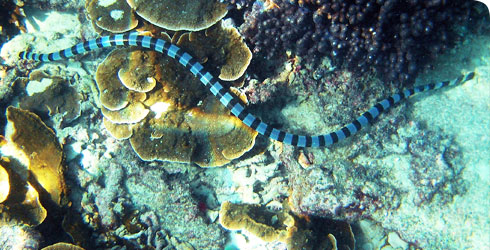Taxonomy
Laticauda crockeri was first described by Slevin in 1934 from a single uniformly dark brown specimen with 21 midbody scale rows, collected in Lake Tegano in 1933. This specimen is preserved in the California Academy of Sciences.
In 1956 Volsøe described a new subspecies (Laticauda laticaudata wolffi) from Lake Tegano based on 3 individuals collected in 1951 (preserved in the Zoological Museum of Copenhagen) and 1 specimen collected in 1953 (preserved in the Natural History Museum, London). These specimens differed from Laticauda crockeri as they had 19 midbody scale rows and black bands on the body.
Subsequent collections have shown that both midbody scale counts and body banding are more variable than originally realised and there is therefore no doubt that L. crockeri and L. laticaudata wolffi are synonyms. However, whether L. crockeri is a distinct species or is a subspecies of L. laticaudata is still debated.
Physical description
Laticauda crockeri has the following features:
- ventrals: 192–210
- subcaudals: 34–39 pairs (males) and 24–30 pairs (females)
- scale rows at midbody: 19–21
- maximum snout-vent length: 615mm (males) and 795mm (females)
- maximum tail length: 91mm (males) and 90mm (females)
- coloration: some individuals are completely dark (melanistic) but where visible, the banding patterns are as follows: total bands 27–47 (body bands 22–35)
Molecular biology and genetics
The venom of L. crockeri has been analysed and compared with that of L. laticaudata. The neurotoxin amino acid sequence differences support the view that L. crockeri is recently derived from L. laticaudata.
Look-alikes
Within the sea kraits (genus Laticauda) L. crockeri most closely resembles the blue-lipped sea krait (Laticauda laticaudata). However it can be distinguished as follows:
Laticauda crockeri:
- midbody scale rows 19, occasionally 21
- ventral scales 192–210
- strong but variable tendency to melanism - some individuals are almost uniformly dark
Laticauda laticaudata:
- midbody scale rows invariably 19
- ventral scales 219–252
- not melanistic - head pattern and body banding usually clearly visible
